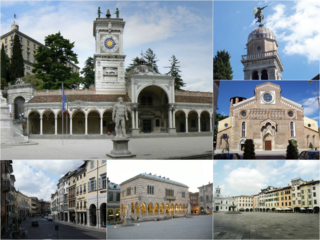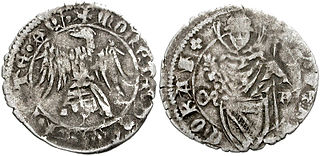
Louis of Teck (Italian: Ludovico di Teck; 1375 - July 1439) was a duke German prelate, who was Patriarch of Aquileia from 1412 until his death. [1]

Louis of Teck (Italian: Ludovico di Teck; 1375 - July 1439) was a duke German prelate, who was Patriarch of Aquileia from 1412 until his death. [1]
Louis of Teck was the last male descendant of the Dukes of Teck in Swabia, born around 1375 to Frederick and Anne of Helfenstein. [2] He matriculated from the Stadium of Padua in 1394 and was awarded citizenship by Francesco Novello da Carrara.
He was elected as patriarch with the help of King Sigismund. During the war with the Republic of Venice which broke out in 1411, he sided for Sigismund, a decision which eventually led to the dissolution of the Aquileian temporal power. In 1418, while most of the Hungarian units were fighting the Ottoman Turks in the Balkans, the Venetians defeated them on the sea and then launched a land offensive against Friuli (the heart of the patriarchate) under Taddeo d'Este and Filippo Arcelli, and the last Aquileian lands in Istria. Capodistria was attacked on 27 August 1418. Aquileia was sacked and Cividale surrendered on 13 July 1419, followed by Sacile on 14 August. Udine, the patriarchate's capital, resisted the troops of Tristano Savorgnan.
Louis received the support of Henry VI of Gorizia. 6,000 patriarchal and Hungarian troops, backed by the Carraresi of Padua and the counts of Oltenburg besieged Cividale for 115 days, but were defeated by a rescue army sent by Venice in December 1419. Henry was captured, while Louis fled to Hungary. The Venetians completed the occupation of Friuli capturing Feltre, Belluno, Portogruaro and Venzone in 1420, while the Cadore and Capodistria surrendered spontaneously.
Louis attempted to invade Friuli in April 1422 with 4,000 men, but was pushed back. Another assault was repelled in September after he had reached Moggio Udinese. His final invasion of 1431 was thwarted by the Venetian condottiero Francesco Bussone, count of Carmagnola.
Louis was a ferocious enemy of Pope Eugenius IV. At the Council of Basel, he proposed that Eugenius was sentenced to death. He also took part in the meeting of German princes at Mainz that elected Amadeus VIII of Savoy as antipope. He died at Basel in July 1439.

Aquileia is an ancient Roman city in Italy, at the head of the Adriatic at the edge of the lagoons, about 10 kilometres (6 mi) from the sea, on the river Natiso, the course of which has changed somewhat since Roman times. Today, the city is small, but it was large and prominent in classical antiquity as one of the world's largest cities with a population of 100,000 in the 2nd century AD and is one of the main archaeological sites of northern Italy. In late antiquity the city was the first city in the Italian Peninsula to be sacked by Attila the Hun.

Udine is a city and comune in north-eastern Italy, in the middle of the Friuli Venezia Giulia region, between the Adriatic Sea and the Alps. Its population was 100,514 in 2012, 176,000 with the urban area.

Friuli is an area of Northeast Italy with its own particular cultural and historical identity containing 1,000,000 Friulians. It comprises the major part of the autonomous region Friuli Venezia Giulia, i.e. the administrative provinces of Udine, Pordenone, and Gorizia, excluding Trieste.

Cividale del Friuli is a town and comune in the Province of Udine, part of the North-Italian Friuli Venezia Giulia regione. The town lies 135 metres (443 ft) above sea-level in the foothills of the eastern Alps, 15 kilometres (9 mi) by rail from the city of Udine and close to the Slovenian border. It is situated on the river Natisone, which forms a picturesque ravine here. Formerly an important regional power, it is today a quiet, small town that attracts tourists thanks to its medieval center.
In the history of Christianity and later of the Roman Catholic Church, there have been several Councils of Aquileia. The Roman city of Aquileia at the head of the Adriatic is the seat of an ancient episcopal see, seat of the Patriarch of Aquileia.

The Patriarchate of Aquileia was an episcopal see in northeastern Italy, centred on the ancient city of Aquileia situated at the head of the Adriatic, on what is now the Italian seacoast. For many centuries it played an important part in history, particularly in that of the Holy See and northern Italy, and a number of church councils were held there.

Saint Paulinus II was a priest, theologian, poet, and one of the most eminent scholars of the Carolingian Renaissance. From 787 to his death, he was the Patriarch of Aquileia. He participated in a number of synods which opposed Spanish Adoptionism and promoted both reforms and the adoption of the Filioque into the Nicene Creed. In addition, Paulinus arranged for the peaceful Christianisation of the Avars and the alpine Slavs in the territory of the Aquileian patriarchate. For this, he is also known as the apostle of the Slovenes.
Campolongo al Torre is a former comune of the Province of Udine in the Italian region Friuli-Venezia Giulia, located about 40 km northwest of Trieste and about 25 km southeast of Udine. Since 2009 it has been one of the two principal centres of Campolongo Tapogliano, a municipality formed by its merger with the former comune of Tapogliano.

Antonio Panciera (1350–1431) was an Italian Cardinal and humanist.

Tommaso Mocenigo (1343–1423) was doge of the Republic of Venice from 1414 until his death.

Lodovico della Torre was Patriarch of Aquileia from 1359 until 1365.
Nicolaus of Luxemburg was Patriarch of Aquileia from 1350 until 1358.

The Patria del Friuli was the territory under the temporal rule of the Patriarch of Aquileia and one of the ecclesiastical states of the Holy Roman Empire. In 1420, the Republic of Venice acquired it, but it continued to be ruled for some time under its own laws and customs.
Francesco Barbaro was a Venetian diplomat and an Italian Catholic bishop

Bertrandof Saint-Geniès was the patriarch of Aquileia from 1334 until his death.

Marquard of Randeck was Patriarch of Aquileia from 1365 until his death.
Taddeo d'Este was a condottiere, a freelance military leader, who was known for his defense of the Republic of Venice in 1439 against Milanese forces under Niccolò Piccinino. Unlike many other condottieri of the day, who often changed sides, he served Venice almost exclusively throughout his thirty-year military career. During most of this period Venice was constantly at war with one or more of the neighboring states in northern Italy.
Pagano della Torre was Patriarch of Aquileia from 1319 until 1332. Another with the same name, Pagano I della Torre, was a Guelph military leader and lord of the Valchiavenna during the first half of the 13th century. Among his grandchildren were Martino, Napoleone, Guido, and Filippo della Torre, all involved in regional conflicts of Lombardy.

Ulrich II von Treven was Patriarch of Aquileia in northern Italy from 1161 to 1181. He supported Frederick I, Holy Roman Emperor, (1122–1190) in his unsuccessful struggle for supremacy over the northern Italian states and the papacy. He was also involved in a dispute over jurisdiction with the Patriarch of Grado where he was ultimately successful.